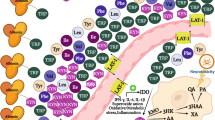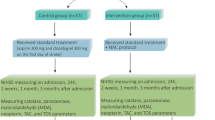Abstract
Post-stroke inflammation may induce upregulation of the kynurenine (KYN) pathway for tryptophan (TRP) oxidation, resulting in neuroprotective (kynurenic acid, KA) and neurotoxic metabolites (3-hydroxyanthranillic acid, 3-HAA). We investigated whether activity of the kynurenine pathway in acute ischemic stroke is related to initial stroke severity, long-term stroke outcome and the ischemia-induced inflammatory response. Plasma concentrations of TRP and its metabolites were measured in 149 stroke patients at admission, at 24 h, at 72 h and at day 7 after stroke onset. We evaluated the relation between the KYN/TRP ratio, the KA/3-HAA ratio and stroke severity, outcome and inflammatory parameters (C-reactive protein (CRP), erythrocyte sedimentation rate (ESR) and neutrophil/lymphocyte ratio (NLR)). KYN/TRP but not KA/3-HAA correlated with the NIHSS score and with the infarct volume. Patients with poor outcome had higher mean KYN/TRP ratios than patients with more favourable outcome. The KYN/TRP ratio at admission correlated with CRP levels, ESR and NLR. The activity of the kynurenine pathway for tryptophan degradation in acute ischemic stroke correlates with stroke severity and long-term stroke outcome. Tryptophan oxidation is related to the stroke-induced inflammatory response.




Similar content being viewed by others
Abbreviations
- 3-HAA:
-
3-hydroxyanthranilic acid
- 3-OH-KYN:
-
3-hydroxykynurenine
- CRP:
-
C-reactive protein
- CT:
-
Computed tomography
- ESR:
-
Erythrocyte sedimentation rate
- IDO:
-
Indolamine 2,3-dioxygenase
- KA:
-
Kynurenic acid
- KYN:
-
Kynurenine
- MRI:
-
Magnetic resonance imaging
- NIHSS:
-
National Institutes of Health Stroke Scale
- NMDA:
-
N-methyl-D-aspartic acid
- NLR:
-
neutrophil/lymphocyte ratio
- QA:
-
Quinolinic acid
- TIA:
-
Transient ischemic attack
- TRP:
-
Tryptophan
References
Brouns R, De Deyn PP (2009) The complexity of neurobiological processes in acute ischemic stroke. Clin Neurol Neurosurg 111:483–495
Croonenberghs J, Spaas K, Wauters A et al (2008) Faulty serotonin–DHEA interactions in autism: results of the 5-hydroxytryptophan challenge test. Neuro Endocrinol Lett 29:385–390
Myint AM, Kim YK, Verkerk R et al (2007) Tryptophan breakdown pathway in bipolar mania. J Affect Disord 102:65–72
Van Gool AR, Verkerk R, Fekkes D et al (2008) Neurotoxic and neuroprotective metabolites of kynurenine in patients with renal cell carcinoma treated with interferon-alpha: course and relationship with psychiatric status. Psychiatry Clin Neurosci 62:597–602
Wichers MC, Koek GH, Robaeys G et al (2005) IDO and interferon-alpha-induced depressive symptoms: a shift in hypothesis from tryptophan depletion to neurotoxicity. Mol Psychiatry 10:538–544
Bonaccorso S, Marino V, Puzella A et al (2002) Increased depressive ratings in patients with hepatitis C receiving interferon-alpha-based immunotherapy are related to interferon-alpha-induced changes in the serotonergic system. J Clin Psychopharmacol 22:86–90
Song C, Lin A, Bonaccorso S et al (1998) The inflammatory response system and the availability of plasma tryptophan in patients with primary sleep disorders and major depression. J Affect Disord 49:211–219
Maes M, Verkerk R, Vandoolaeghe E et al (1997) Serotonin-immune interactions in major depression: lower serum tryptophan as a marker of an immune-inflammatory response. Eur Arch Psychiatry Clin Neurosci 247:154–161
Myint AM, Kim YK, Verkerk R et al (2007) Kynurenine pathway in major depression: evidence of impaired neuroprotection. J Affect Disord 98:143–151
Stone TW, Mackay GM, Forrest CM et al (2003) Tryptophan metabolites and brain disorders. Clin Chem Lab Med 41:852–859
Taguchi A, Hara A, Saito K et al (2008) Localization and spatiotemporal expression of IDO following transient forebrain ischemia in gerbils. Brain Res 1217:78–85
Cozzi A, Carpenedo R, Moroni F (1999) Kynurenine hydroxylase inhibitors reduce ischemic brain damage: studies with (m-nitrobenzoyl)-alanine (mNBA) and 3, 4-dimethoxy-[-N-4-(nitrophenyl)thiazol-2yl]-benzenesulfonamide (Ro 61–8048) in models of focal or global brain ischemia. J Cereb Blood Flow Metab 19:771–777
Darlington LG, Mackay GM, Forrest CM et al (2007) Altered kynurenine metabolism correlates with infarct volume in stroke. Eur J Neurosci 26:2211–2221
Bender DA, McCreanor GM (1985) Kynurenine hydroxylase: a potential rate-limiting enzyme in tryptophan metabolism. Biochem Soc Trans 13:441–443
Alberati-Giani D, Cesura AM (1998) Expression of the kynurenine enzymes in macrophages and microglial cells: regulation by immune modulators. Amino Acids 14:251–255
Swartz KJ, During MJ, Freese A, Beal MF (1990) Cerebral synthesis and release of kynurenic acid: an endogenous antagonist of excitatory amino acid receptors. J Neurosci 10:2965–2973
Okuda S, Nishiyama N, Saito H, Katsuki H (1998) 3-Hydroxykynurenine, an endogenous oxidative stress generator, causes neuronal cell death with apoptotic features and region selectivity. J Neurochem 70:299–307
Stone TW, Perkins MN (1981) Quinolinic acid: a potent endogenous excitant at amino acid receptors in CNS. Eur J Pharmacol 72:411–412
Taylor MW, Feng GS (1991) Relationship between interferon-gamma, indoleamine 2, 3-dioxygenase, and tryptophan catabolism. FASEB J 5:2516–2522
Fukui S, Schwarcz R, Rapoport SI et al (1991) Blood-brain barrier transport of kynurenines: implications for brain synthesis and metabolism. J Neurochem 56:2007–2017
Brouns R, Sheorajpanday R, Wauters A et al (2008) Evaluation of lactate as a marker of metabolic stress and cause of secondary damage in acute ischemic stroke or TIA. Clin Chim Acta 397:27–31
Brouns R, Heylen E, Sheorajpanday R et al (2009) Carboxypeptidase U (TAFIa) decreases the efficacy of thrombolytic therapy in ischemic stroke patients. Clin Neurol Neurosurg 111:165–170
Brouns R, Sheorajpanday R, Kunnen J et al (2009) Clinical, biochemical and neuroimaging parameters after thrombolytic therapy predict long-term stroke outcome. Eur Neurol 62:9–15
Brouns R, Marescau B, Possemiers I et al (2009) Dimethylarginine levels in cerebrospinal fluid of hyperacute ischemic stroke patients are associated with stroke severity. Neurochem Res 34:1642–1649
Brouns R, Van Den Bossche J, De Surgeloose D et al (2009) Clinical and biochemical diagnosis of small-vessel disease in acute ischemic stroke. J Neurol Sci 285:185–190
Brouns R, Heylen E, Willemse JL et al (2010) The decrease in procarboxypeptidase U (TAFI) concentration in acute ischemic stroke correlates with stroke severity, evolution and outcome. J Thromb Haemost 8:75–80
Schroecksnadel K, Fiegl M, Prassl K et al (2007) Diminished quality of life in patients with cancer correlates with tryptophan degradation. J Cancer Res Clin Oncol 133:477–485
Pawlak K, Brzosko S, Mysliwiec M, Pawlak D (2009) Kynurenine, quinolinic acid-The new factors linked to carotid atherosclerosis in patients with end-stage renal disease. Atherosclerosis 204:561–566
Logters TT, Laryea MD, Altrichter J et al. (2008) Increased plasma kynurenine values and kynurenine: tryptophan ratios after major trauma are early indicators for the development of sepsis. Shock (in press)
Heyes MP, Saito K, Devinsky O, Nadi NS (1994) Kynurenine pathway metabolites in cerebrospinal fluid and serum in complex partial seizures. Epilepsia 35:251–257
Sulter G, Steen C, De Keyser J (1999) Use of the Barthel index and modified Rankin scale in acute stroke trials. Stroke 30:1538–1541
Dziedzic T (2008) Clinical significance of acute phase reaction in stroke patients. Front Biosci 13:2922–2927
Forrest CM, Mackay GM, Stoy N et al (2004) Tryptophan loading induces oxidative stress. Free Radic Res 38:1167–1171
Herve C, Beyne P, Jamault H, Delacoux E (1996) Determination of tryptophan and its kynurenine pathway metabolites in human serum by high-performance liquid chromatography with simultaneous ultraviolet and fluorimetric detection. J Chromatogr B Biomed Appl 675:157–161
Pawlak D, Pawlak K, Malyszko J et al (2001) Accumulation of toxic products degradation of kynurenine in hemodialyzed patients. Int Urol Nephrol 33:399–404
Mackay GM, Forrest CM, Stoy N et al (2006) Tryptophan metabolism and oxidative stress in patients with chronic brain injury. Eur J Neurol 13:30–42
McMillan DC (2009) Systemic inflammation, nutritional status and survival in patients with cancer. Curr Opin Clin Nutr Metab Care 12:223–226
Stone TW, Darlington LG (2002) Endogenous kynurenines as targets for drug discovery and development. Nat Rev Drug Discov 1:609–620
Acknowledgments
Raf Brouns was a research assistant of the Fund for Scientific research Flanders (FWO-Vlaanderen). This research was also supported by the Institute Born-Bunge; the agreement between the Institute Born-Bunge and the University of Antwerp; the Interuniversity Attraction Poles (IAP) program P6/43 of the Belgian Federal Science Policy Office, Belgium; and the Medical Research Foundation Antwerp.
Conflict of Interests
None
Author information
Authors and Affiliations
Corresponding author
Rights and permissions
About this article
Cite this article
Brouns, R., Verkerk, R., Aerts, T. et al. The Role of Tryptophan Catabolism along the Kynurenine Pathway in Acute Ischemic Stroke. Neurochem Res 35, 1315–1322 (2010). https://doi.org/10.1007/s11064-010-0187-2
Accepted:
Published:
Issue Date:
DOI: https://doi.org/10.1007/s11064-010-0187-2




